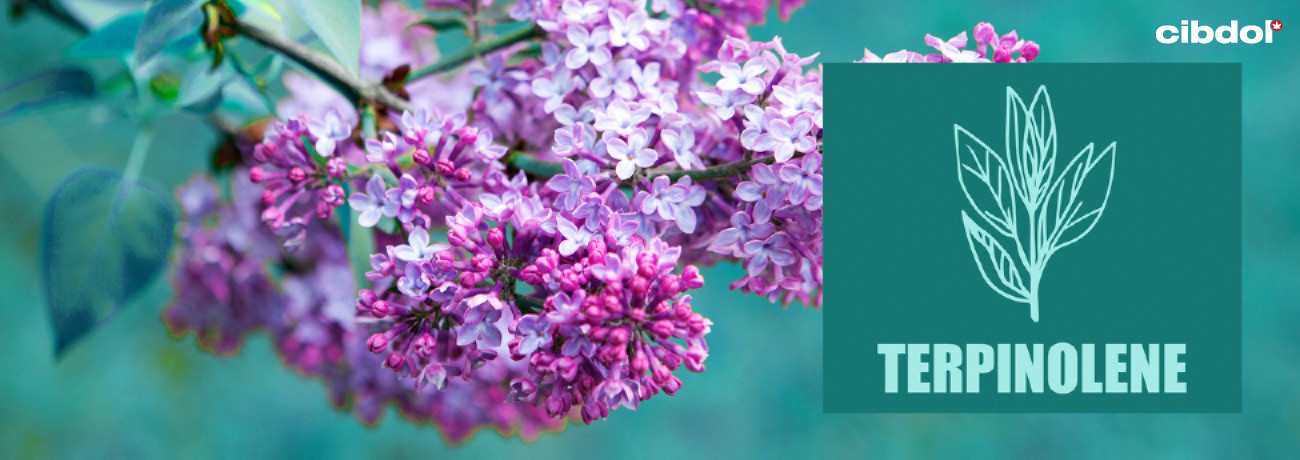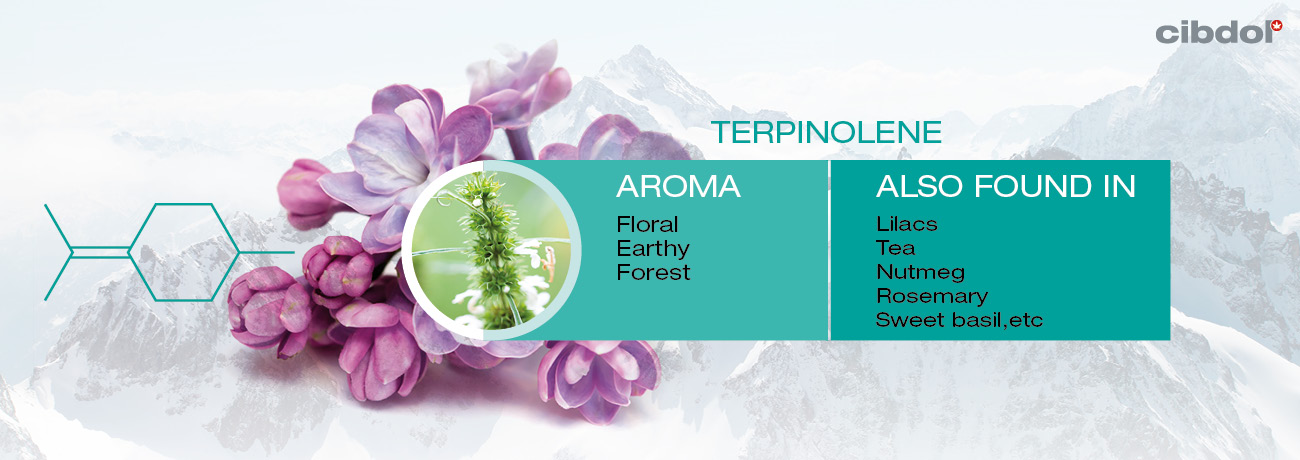What Is Terpinolene?

Terpinolene is one of over 200 terpenes produced by the cannabis plant. The molecule appears in many modern cannabis chemovars—albeit in relatively low quantities compared to other members of the same chemical class. Researchers note that the terpene mostly appears in sativa-type varieties[1].
As a monoterpene, terpinolene is a small and simple molecule. Two isoprene units define its molecular structure and place it into this category alongside the likes of limonene and myrcene.
Despite its scarcity, terpinolene still contributes significantly to the overall aroma of many cannabis strains—a clear testimony to its pungency. But its strong scent wasn’t developed for the sensory enjoyment of humans alone.
Cannabis plants produce terpinolene—alongside a host of other terpenes and cannabinoids—to defend against pest insects and fungal pathogens, thanks to the molecule’s larvicidal and antifungal capabilities.
It might be a small molecule, but it's full of promise. Scientific research continues to uncover terpinolene’s therapeutic potential. Although most of these findings are still early, terpinolene could be a major player in the future of cannabis science.
Let’s take a look at the characteristics of terpinolene, and see what the latest research has to say about the terpene.
Aroma
Terpinolene harnesses the aromas of the forest. To sum up the terpene: it's earthy and fresh, providing distinct scents of pine, wood, flowers, herbs, and subtle notes of citrus. It’s easy to see why companies utilise the chemical when designing products such as soaps and perfumes.
Also found in
Terpinolene appears in various plant species throughout nature. It occurs in varying concentrations within narrow-leaf tea tree, celery, Scots pine, nutmeg, sweet marjoram, valerian, oregano, cilantro, rosemary, sweet basil, sage, and ginger.
Wild parsnip contains the highest levels of terpinolene in nature. The essential oil of the plant contains around 69% of the chemical.

Possible effects
Like many of the constituents found in the cannabis plant, terpinolene displays some interesting therapeutic effects. However, we’re still in the early stages of research. There’s a distinct lack of human clinical trials.
However, animal and cell studies offer a glimpse into what the future of terpinolene research could reveal.
So far, the terpene appears to produce the following effects:
• Antitumour
• Antioxidant
• Analgesic
• Anti-inflammatory
• Possible sedative
• May protect against cardiovascular diseases
Supporting research
Several studies have demonstrated the antitumour potential of terpinolene. The molecule appears to alter signalling pathways that prompt the survival and growth of cancer cells. Research[2] published in the journal Oncology Letters documents how terpinolene achieves these effects.
The study found the terpene to be effective at reducing the expression of a protein kinase known as AKT. Also known as protein kinase B, AKT contributes to cancer progression by way of mediating cell proliferation and survival signals. Therefore, it makes sense that increased expression AKT is implicated in numerous types of human cancers.
Interestingly, researchers found cells treated with sage or rosemary extract to display reduced expression of the protein kinase. Upon further investigation, they found terpinolene—an active constituent of both plant species—to be capable of achieving these effects.
Additional research[3], published in 2013, tested terpinolene on the proliferation of rat brain tumour cells. Researchers found the terpene to produce significant effects when administered to neuroblastoma cells. They concluded that terpinolene produces potent antiproliferative effects and may have potential use as an anticancer agent.
Terpinolene may also have potential as an antioxidant. Research[4] published in the journal Cytotechnology set out to test the effects of the molecule on human lymphocytes—a subtype of white blood cells.
Researchers exposed the cells to the terpene for periods of 24 and 48 hours. The researchers found antioxidant activity, along with no genotoxic effects. They concluded that terpinolene could be a “new resource of therapeutics” due to its antioxidant activities.
Terpinolene may help to reduce both pain and swelling. A 2016 study[5] published in the Brazillian Journal of Medical and Biological Research found the terpene to synergise with common anti-inflammatory drugs.
Researchers administered a blend of terpinolene and the non-steroidal anti-inflammatory drug (NSAID) Diclofenac to mice. The concoction decreased levels of inflammatory biomarkers and pain, possibly by acting on serotonin receptors. Furthermore, the two chemicals produced these effects without causing gastric injury—a side effect of NSAIDs.
The jury remains out on whether terpinolene produces sedating or stimulating effects. Research[6] found that a dose as low as 0.1mg reduced motor activity by 67.8%. If future human studies display similar results, terpinolene could play a beneficial role in conditions such as anxiety and insomnia.
Finally, current research[7] suggests that terpinolene could help to protect against certain cardiovascular conditions. The molecule may help to protect against the oxidation of low-density lipoprotein (LDL). Known as the “bad” type of cholesterol, LDL can build up in the arteries and contribute to heart attacks and strokes.
Oxidation of LDL—caused by roaming free radicals—may cause a hardening of the arteries. By reducing the oxidation of LDL, terpinolene may help to prevent such diseases.
[1] Hazekamp, A., Tejkalová, K., & Papadimitriou, S. (2016). Cannabis: From Cultivar to Chemovar II—A Metabolomics Approach to Cannabis Classification. Cannabis and Cannabinoid Research, 1(1), 202–215. https://doi.org/10.1089/can.2016.0017 [Source]
[2] OKUMURA, N., YOSHIDA, H., NISHIMURA, Y., KITAGISHI, Y., & MATSUDA, S. (2011). Terpinolene, a component of herbal sage, downregulates AKT1 expression in K562 cells. Oncology Letters, 3(2), 321–324. https://doi.org/10.3892/ol.2011.491 [Source]
[3] Aydin, E., Türkez, H., & Geyikoğlu, F. (2013). Antioxidative, anticancer and genotoxic properties of α-pinene on N2a neuroblastoma cells. Biologia, 68(5), 1004–1009. https://doi.org/10.2478/s11756-013-0230-2 [Source]
[4] Turkez, H., Aydin, E., & Geyikoglu, F. (2014). Genotoxic and oxidative damage potentials in human lymphocytes after exposure to terpinolene in vitro. Springer Link. https://link.springer.com/article/10.1007/s10616-014-9698-z [Source]
[5] Macedo, E., Santos, W., Sousa Neto, B., Lopes, E., Piauilino, C., Cunha, F., Sousa, D., Oliveira, F., & Almeida, F. (2016). Association of terpinolene and diclofenac presents antinociceptive and anti-inflammatory synergistic effects in a model of chronic inflammation. Brazilian Journal of Medical and Biological Research, 49(7). https://doi.org/10.1590/1414-431x20165103 [Source]
[6] Russo, E. B., & Marcu, J. (2017). Cannabis Pharmacology: The Usual Suspects and a Few Promising Leads. Cannabinoid Pharmacology, 67–134. https://doi.org/10.1016/bs.apha.2017.03.004 [Source]
[7] Graßmann, J., Hippeli, S., Spitzenberger, R., & Elstner, E. (2005). The monoterpene terpinolene from the oil of Pinus mugo L. in concert with α-tocopherol and β-carotene effectively prevents oxidation of LDL. Phytomedicine, 12(6–7), 416–423. https://doi.org/10.1016/j.phymed.2003.10.005 [Source]
[1] Hazekamp, A., Tejkalová, K., & Papadimitriou, S. (2016). Cannabis: From Cultivar to Chemovar II—A Metabolomics Approach to Cannabis Classification. Cannabis and Cannabinoid Research, 1(1), 202–215. https://doi.org/10.1089/can.2016.0017 [Source]
[2] OKUMURA, N., YOSHIDA, H., NISHIMURA, Y., KITAGISHI, Y., & MATSUDA, S. (2011). Terpinolene, a component of herbal sage, downregulates AKT1 expression in K562 cells. Oncology Letters, 3(2), 321–324. https://doi.org/10.3892/ol.2011.491 [Source]
[3] Aydin, E., Türkez, H., & Geyikoğlu, F. (2013). Antioxidative, anticancer and genotoxic properties of α-pinene on N2a neuroblastoma cells. Biologia, 68(5), 1004–1009. https://doi.org/10.2478/s11756-013-0230-2 [Source]
[4] Turkez, H., Aydin, E., & Geyikoglu, F. (2014). Genotoxic and oxidative damage potentials in human lymphocytes after exposure to terpinolene in vitro. Springer Link. https://link.springer.com/article/10.1007/s10616-014-9698-z [Source]
[5] Macedo, E., Santos, W., Sousa Neto, B., Lopes, E., Piauilino, C., Cunha, F., Sousa, D., Oliveira, F., & Almeida, F. (2016). Association of terpinolene and diclofenac presents antinociceptive and anti-inflammatory synergistic effects in a model of chronic inflammation. Brazilian Journal of Medical and Biological Research, 49(7). https://doi.org/10.1590/1414-431x20165103 [Source]
[6] Russo, E. B., & Marcu, J. (2017). Cannabis Pharmacology: The Usual Suspects and a Few Promising Leads. Cannabinoid Pharmacology, 67–134. https://doi.org/10.1016/bs.apha.2017.03.004 [Source]
[7] Graßmann, J., Hippeli, S., Spitzenberger, R., & Elstner, E. (2005). The monoterpene terpinolene from the oil of Pinus mugo L. in concert with α-tocopherol and β-carotene effectively prevents oxidation of LDL. Phytomedicine, 12(6–7), 416–423. https://doi.org/10.1016/j.phymed.2003.10.005 [Source]












